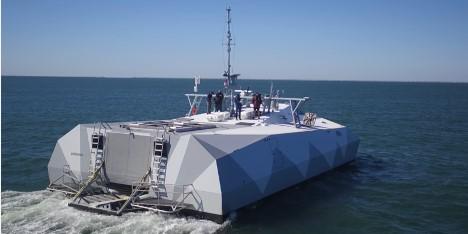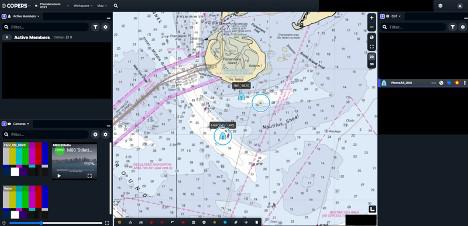Navy Examines UAS Remote Identification Platform
Indianapolis-based Pierce Aerospace announced on March 16 that it had signed a Cooperative Research and Development Agreement (CRADA) with the U.S. Navy’s Naval Surface Warfare Center Carderock. The CRADA with the warfare center will run for three years and will help the Navy consider solutions to remotely identify autonomous aerial vehicles, Aaron Pierce, CEO of Pierce Aerospace, told SIGNAL Magazine.
In the future, the Federal Aviation Administration (FAA) will require unmanned aerial systems (UAS) between the weight of .55 to 55 pounds to provide remote identification (ID). As a remote ID service provider, Pierce Aerospace offers remote ID receivers, broadcast modules and remote ID integrations for original equipment manufacturers, counter-UAS, command and control and unmanned aircraft traffic management (UTM) providers.
Pierce Aerospace's Flight Portal ID product line includes broadcast modules for UAS integration and ground receivers that passively listen for remote ID messages and network those messages into client command and control, C-UAS or UTM systems. Last year Pierce Aerospace joined Esri's Partner Network, providing capabilities for upcoming integrations into Esri's geospatial intelligence, mapping, and spatial analysis tools—following an agreement with Esri. In addition, Pierce Aerospace provided initial integrations of remote and combat ID data through its Flight Portal ID platform for Northrop Grumman Corp. and U.S. Army command and control systems for use in dense urban airspace environments as well as for live-fire activity. According to Pierce, related solutions are also available for enterprise and government stakeholders.
Under the CRADA with the Navy, the company conducted experiments to test its UAS remote ID capabilities aboard the service’s M80 Stiletto—the service’s next-generation, high-speed, carbon-fiber, unique-hull prototype ship manufactured by the M Ship Company—during the Navy’s Thunderstorm 2021 exercise last October in the Chesapeake Bay. It was the first such sea domain experiment for Pierce Aerospace’s Flight Portal ID and Remote ID technology suite, the CEO reported. The company also conducted tests at the Radio Renaissance Company's Crucible facility in Fredericksburg, Virginia, in November.
“This was the first-time stress testing Flight Portal ID in a maritime environment, exposing the system to vibration, shock, sea state and marine airspace while aboard a U.S. Navy vessel,” Pierce explained. “The experiment was very valuable to our ongoing prototype development, and we immediately began iterating with lessons learned from the maritime environment.”
Since the M80 Stiletto was originally developed for naval special warfare and has a history of supporting next-generation technology and prototype experimentation, it was an effective setting for the event, Pierce said. The M80 Stiletto provided multiple assets for the experimentation, including several rigid inflatable boats, a jet ski and an unmanned surface vessel (USV). San Diego-based SeaSatellites supplied the USV, its autonomous Seasat X3, which has a modular, flat payload bay for landing UAS or carrying other sensors. UAS at the event were equipped with Flight Portal ID Broadcast Modules while Flight Portal ID Receivers were located aboard the M80 Stiletto and rigid inflatable boats. In addition, Pierce Aerospace integrated the Flight Portal ID platform into the Air Force Research Laboratory’s (AFRL’s) Common Operating Picture for Event Response Situational Awareness system, known as COPERS.
“COPERS is designed for diverse integration and delivers superior situational awareness across a wide range of users,” Pierce noted. “And it was exciting to conduct our first integration into COPERS and provide U.S. government stakeholders with an opportunity to remotely view the Remote ID tracks produced by drones equipped with our Flight Portal ID Remote ID broadcast modules. This was a unique opportunity for us to demonstrate dual-use capabilities in a joint force implementation with U.S. Navy and U.S. Air Force technology at the same time.”
AFRL’s system was created by Houston-based Centauri/KBR to provide a distributed web-based common operational picture that enables a wide range of approved users to login and participate or observe events. Pierce Aerospace officials integrated into COPERS before arriving dockside for the experiment.
“Their technology, coupled with the situational awareness power of COPERS provided a picture of the operational space that had not been previously available,” said Preston Hoeve, Centauri/KBR’s COPERS principle investigator. “We are excited to continue our work with the Pierce Aerospace team.”
Navy officials reportedly characterized Pierce Aerospace’s participation as an opportunity to demonstrate Flight Portal ID in a realistic maritime environment against the backdrop of a relevant tactical scenario.
“The focus of this demonstration was joint contested logistics,” said Dennis Danko, program manager, Naval Surface Warfare Center Carderock. “We selected 10 technologies, integrated them into the boat and conducted underwater experiments over a couple weeks. One of the highlights was the ability and willingness of technology providers like Pierce Aerospace to collaborate and combine new technologies in innovative ways to address a common tactical goal.”
Funds from the U.S. Air Force and the state of Indiana are aiding the company’s developments in remote ID. In addition, officials from Pierce Aerospace serve on the FAA’s government-industry Unmanned Aircraft Safety Team, the American Society for Testing and Materials (ASTM) International’s ASTM F38 UAS Remote ID Committee and the FAA’s Remote ID Cohort.
“I am very grateful for our team’s opportunity to work with NSWC Carderock and the entire M80 Stiletto team. Stiletto provides an unmatched and unique platform that enables us to integrate and then iterate our dual-use UAS Remote ID technology in a maritime environment with technology relevant to our stakeholders. We look forward to going out to sea with the team again.”






Comments